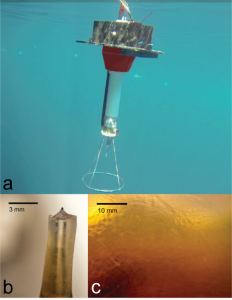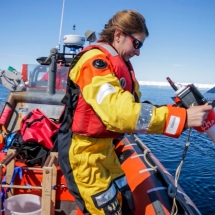The silent scale
This motion, which we refer to as the kinetic energy of the ocean, comes from solar radiative energy and the tidal forces exerted by the sun and the moon. Terawatts of kinetic energy are injected to the ocean (1 terawatt = 1012 watts). The low viscosity of seawater and the scale of oceanic basins render the motion highly turbulent, meaning that the flow is populated with swirls of all sizes that stretch and fold the fluid on itself. Large swirl end up breaking up into smaller ones until viscous forces dissipates the kinetic into heat or potential energy. This happens when swirls are a few millimeters wide. It is easily possible to see how this happens only by looking at two fluids of different densities, say an ice cube melting at the surface of a glass filled with warm salty water that we gently mix (Fig. 1c).
This is thus at the millimeter scale that the noisy turbulent motion of the ocean cease and that everything becomes invariably calm. Microscopic phytoplankton cells, bacteria and viruses live in such a calm world where viscous forces dominate. We would experience a similar if we, humans, were living into a fluid having the same viscosity as molasses.
To quantify the efficiency at which turbulence mixes sea water and its content is a difficult but nonetheless crucially important problem if one wants to describe the environment in which microscopic marine plants and animal live. The primary production, for example, strongly depends on fluxes of nutrients transported from the ocean interior to the euphotic zone – where there is light – by turbulent motion. To measure the turbulence, we use a SCAMP (Self-Contained Autonomous MicroProfiler), an instrument that possesses miniature temperature sensors (around 200 mm, Fig. 1b) capable of detecting temperature variations at the millimeter scale over the first 90 meters of the water column. This instrument is deployed from a zodiac, far from the turbulence induced by the icebreaker, and records the ocean’s microstructure while falling freely at a speed of 10 cm/s (Fig. 1a).

Figure 1. a. The SCAMP MicroProfiler falling freely at a speed of 10 cm/s in the icy Baffin Bay waters. The sensors are located at the bottom of the instrument, protected by a metal cage. b. Closeup of a sensor measuring the micro-variations of the temperature during its journey. c. Filaments and swirls bring together two different fluid densities, here freshwater from melting ice surface and colored salt water. Filamentary structures are made visible by the refraction of ambient light through the fluids of different refractive indices. Credit photos: Sharif Mirshak
During the GreenEdge expedition, the SCAMP has been deployed many times in small polynyas within the ice pack, and often near spectacularly beautiful icebergs. Marine physicists cruising on board the zodiac had the chance to leave the noisy environment of the ship and to comer closer, like the SCAMP, to that place where suddenly everything becomes calm.

